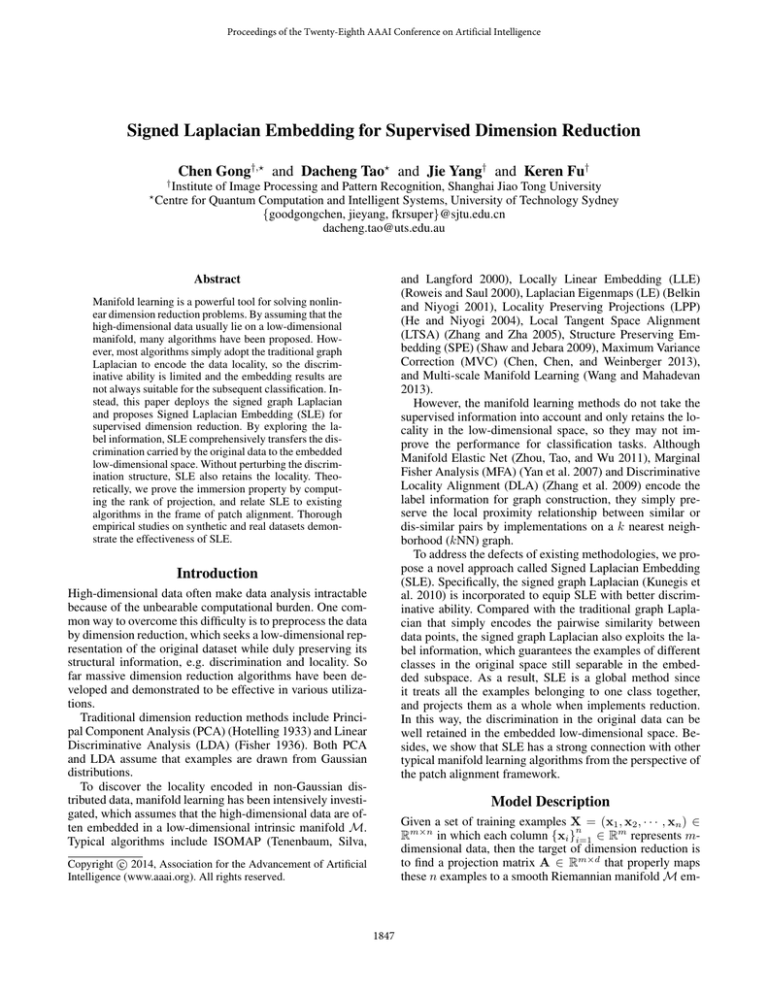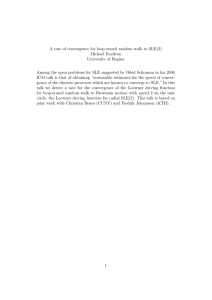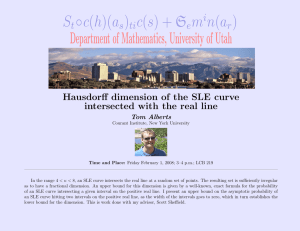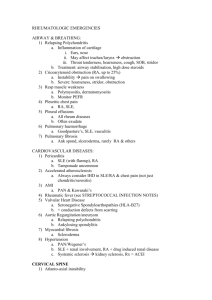
Proceedings of the Twenty-Eighth AAAI Conference on Artificial Intelligence
Signed Laplacian Embedding for Supervised Dimension Reduction
Chen Gong†,? and Dacheng Tao? and Jie Yang† and Keren Fu†
?
†
Institute of Image Processing and Pattern Recognition, Shanghai Jiao Tong University
Centre for Quantum Computation and Intelligent Systems, University of Technology Sydney
{goodgongchen, jieyang, fkrsuper}@sjtu.edu.cn
dacheng.tao@uts.edu.au
Abstract
and Langford 2000), Locally Linear Embedding (LLE)
(Roweis and Saul 2000), Laplacian Eigenmaps (LE) (Belkin
and Niyogi 2001), Locality Preserving Projections (LPP)
(He and Niyogi 2004), Local Tangent Space Alignment
(LTSA) (Zhang and Zha 2005), Structure Preserving Embedding (SPE) (Shaw and Jebara 2009), Maximum Variance
Correction (MVC) (Chen, Chen, and Weinberger 2013),
and Multi-scale Manifold Learning (Wang and Mahadevan
2013).
However, the manifold learning methods do not take the
supervised information into account and only retains the locality in the low-dimensional space, so they may not improve the performance for classification tasks. Although
Manifold Elastic Net (Zhou, Tao, and Wu 2011), Marginal
Fisher Analysis (MFA) (Yan et al. 2007) and Discriminative
Locality Alignment (DLA) (Zhang et al. 2009) encode the
label information for graph construction, they simply preserve the local proximity relationship between similar or
dis-similar pairs by implementations on a k nearest neighborhood (kNN) graph.
To address the defects of existing methodologies, we propose a novel approach called Signed Laplacian Embedding
(SLE). Specifically, the signed graph Laplacian (Kunegis et
al. 2010) is incorporated to equip SLE with better discriminative ability. Compared with the traditional graph Laplacian that simply encodes the pairwise similarity between
data points, the signed graph Laplacian also exploits the label information, which guarantees the examples of different
classes in the original space still separable in the embedded subspace. As a result, SLE is a global method since
it treats all the examples belonging to one class together,
and projects them as a whole when implements reduction.
In this way, the discrimination in the original data can be
well retained in the embedded low-dimensional space. Besides, we show that SLE has a strong connection with other
typical manifold learning algorithms from the perspective of
the patch alignment framework.
Manifold learning is a powerful tool for solving nonlinear dimension reduction problems. By assuming that the
high-dimensional data usually lie on a low-dimensional
manifold, many algorithms have been proposed. However, most algorithms simply adopt the traditional graph
Laplacian to encode the data locality, so the discriminative ability is limited and the embedding results are
not always suitable for the subsequent classification. Instead, this paper deploys the signed graph Laplacian
and proposes Signed Laplacian Embedding (SLE) for
supervised dimension reduction. By exploring the label information, SLE comprehensively transfers the discrimination carried by the original data to the embedded
low-dimensional space. Without perturbing the discrimination structure, SLE also retains the locality. Theoretically, we prove the immersion property by computing the rank of projection, and relate SLE to existing
algorithms in the frame of patch alignment. Thorough
empirical studies on synthetic and real datasets demonstrate the effectiveness of SLE.
Introduction
High-dimensional data often make data analysis intractable
because of the unbearable computational burden. One common way to overcome this difficulty is to preprocess the data
by dimension reduction, which seeks a low-dimensional representation of the original dataset while duly preserving its
structural information, e.g. discrimination and locality. So
far massive dimension reduction algorithms have been developed and demonstrated to be effective in various utilizations.
Traditional dimension reduction methods include Principal Component Analysis (PCA) (Hotelling 1933) and Linear
Discriminative Analysis (LDA) (Fisher 1936). Both PCA
and LDA assume that examples are drawn from Gaussian
distributions.
To discover the locality encoded in non-Gaussian distributed data, manifold learning has been intensively investigated, which assumes that the high-dimensional data are often embedded in a low-dimensional intrinsic manifold M.
Typical algorithms include ISOMAP (Tenenbaum, Silva,
Model Description
Given a set of training examples X = (x1 , x2 , · · · , xn ) 2
n
Rm⇥n in which each column {xi }i=1 2 Rm represents mdimensional data, then the target of dimension reduction is
to find a projection matrix A 2 Rm⇥d that properly maps
these n examples to a smooth Riemannian manifold M em-
Copyright c 2014, Association for the Advancement of Artificial
Intelligence (www.aaai.org). All rights reserved.
1847
However, this measure simply focuses on preserving the local structure among examples, and Wij (i, j = 1, 2, · · · , n)
are required to be nonnegative.
In contrast, we claim that: 1) The examples belonging to
the same class, not simply originally nearby, are better to be
projected together for the subsequent classification; 2) The
elements in the adjacency matrix are allowed to take negative values to enable the incorporation of both similarity and
dissimilarity information, so that better discriminative performance can be achieved. Therefore, taking the two-class
situation as an example, we aim to minimize the following
objective function:
1 Xn X n
2
(yi sij yj ) W̃ij ,
(3)
Q=
i=1
j=1
2
0 and sij = 1 if W̃ij <
in which sij = 1 if W̃ij
0. Suppose a is a projection vector, namely yiT = aT xi ,
bedded in a low-dimensional ambient space Rd with d < m.
Moreover, a dimension reduction method should have the
generalizability that accurately predicts the low-dimensional
representation of unseen test data xt 2 Rm as yt = AT xt .
Signed Graph Laplacian
Popular manifold learning algorithms, such as LPP (He and
Niyogi 2004) and LE (Belkin and Niyogi 2001), usually use
a graph G = (V, E) to represent the training set X, in which
n
V is the vertex set composed of the examples {xi }i=1 , and E
is the edge set recording the relationship between them. The
(i, j)-th element of the G’s adjacency matrix W is computed
2
as Wij = exp(kxi xj k / 2 ) ( is the kernel width) if
xj is one of the k nearest neighbors of xi , and Wij = 0
otherwise.
P Furthermore, by defining a diagonal matrix D as
Dii =
j Wij for i = 1, 2, · · · , n, the traditional graph
Laplacian is formulated as L = D W.
Note that L above is only suitable for the W with elements in the range [0, 1]. In contrast, Kunegis et al. (2010)
studies the signed graph G̃, and defines a novel adjacency
matrix W̃ which contains both positive and negative elements. A diagonal matrix D̃ is then represented as D̃ii =
P
j W̃ij (i = 1, 2, · · · , n), and the signed graph Lapla-
and considering that s2ij = 1 and W̃ij sij = W̃ij , (3) is
reformulated as
2
1 Xn X n
Q=
(aT xi aT xj sij ) W̃ij
i=1
j=1
2
Xn X n T
Xn T
a xi D̃ii xTi a
a xi W̃ij sij xTj a
=
i=1
T
.
W̃)X a
T
= a XL̃X a
(4)
Moreover, to uniquely determine the minimizer a, an additional constraint is imposed as
The Algorithm
Based on the signed graph Laplacian introduced above, SLE
is proposed and is divided into two major steps:
(5)
aT XXT a = 1.
Consequently, our task is to find the solution to the following
optimization problem:
1. Signed graph construction: The vertices of G̃ corren
spond to the training examples {xi }i=1 . xi and xj are
connected by a positive edge if they belong to the same
class, while they are linked by a negative edge if they
come from different classes. Therefore, the elements in
the adjacency matrix W̃ are
⇢
j=1
T
= a X(D̃
cian is given by L̃ = D̃ W̃. Similar to L, it is easy to
verify that L̃ is also positive semi-definite.
W̃ij =
i=1
T
min aT XL̃XT a
.
(6)
s.t. aT XXT a = 1
By applying the Lagrangian multiplier method (Boyd and
Vandenberghe 2004), (6) can be transformed into a generalized eigenvalue problem which shares the same formation
as (2).
a
1, xi and xj are in the same class
.
1, xi and xj are in the dif f erent classes
(1)
Extension to Multi-class Situations
2. Finding the projection matrix: The following generalized eigenvalue problem (2) is to be solved:
The current model (6) is only suitable for two-class situations because its objective function (3) simply “pushes” the
xj ’s low-dimensional embedding yj to yi if xj belongs to
a different class from xi , which will definitely cause ambiguity in multi-class situations.
We use the “one-versus-the-rest” strategy to adapt SLE to
multiple classes. Suppose there are C classes in total, a projection matrix Ai is explicitly trained by (6) for each class
ci (i = 1, 2, · · · , C), so that all the examples belonging to ci
(denoted as X(i) ) are mapped to Y(i) = ATi X(i) , while the
examples of other classes (denoted as X̄(i) ) are embedded
together as Ȳ(i) = ATi X̄(i) . To address the example imbalance problem during this process, we re-weight the W̃ij in
(1) to 1/nci (nci is the number of examples in ci ) if xi and
xj share the same label. Then, for test data xt we implement dimension reduction using A1 , A2 , · · · , AC respec-
(2)
XL̃XT a = XXT a.
Suppose 1 , 2 , · · · , d are the eigenvalues obtained and
arranged in ascending order, and the corresponding eigenvectors are a1 , a2 , · · · , ad , respectively, then the projection matrix is Am⇥d = (a1 , a2 , · · · , ad ). Let Y =
(y1 , y2 , · · · , yn ) 2 Rd⇥n denote the embedding results
of the training data, then the projection on X can be easily expressed as Y = AT X.
Model Justification
As introduced above, the kNN graph is usually adopted by
the existing manifold-based methods, and requires that the
adjacent examples in Rm are not mapped far apart in Rd . In
P
2
other words, their target is to minimize ij (yi yj ) Wij .
1848
(1)
(2)
Rank of Projection
(C)
tively. The corresponding results are yt , yt , · · · , yt ,
and the membership degree that xt belongs to the i-th class
is then calculated by
Suppose M and N are two manifolds, and f : M ! N
is a smooth mapping between them, then for each point p 2
M, the Jacobian dfp of f defines a linear mapping from the
tangent plane of M at p (denoted as Tp (M)), to the tangent
plane of N at f (p) (denoted as Tf (p) (N )). The definition
for the rank of f is provided in Definition 1, based on which
we investigate the rank of SLE in this section.
(i)
✓(i) =
(i)
minj d(yt(i) , Ȳ·j )
(i)
minj d(yt(i) , Y·j )
.
(7)
In (7), Y·j denotes the j-th column of the matrix Y(i) ,
and d(·, ·) represents the Euclidean distance between two
vectors. Consequently, xt is classified into the class ct =
arg max1iC ✓(i), and its corresponding projection matrix
is Act .
Definition 1 (Rank, (Joncas and Meila 2013)) A smooth
mapping fi (x1 , · · · , xm ) : M ! N with i = 1, 2, · · · , d
has rank(f ) = r if the Jacobian dfp : Tp M ! Tf (p) N of
the map has rank r for all points p = (xp1 , · · · , xpm ) 2 M,
which is defined by
0 @f1
@f1 1
· · · @x
@x1
m
B
.. C .
..
(11)
J = @ ...
.
. A
@fd
@fd
· · · @xm
@x1
Theoretical Analyses
This section studies some theoretical properties related to
SLE. We reveal that SLE has a solid statistical background,
and prove that SLE is essentially an immersion between two
smooth manifolds.
Statistical Viewpoint of SLE
According to Definition 1, the Jacobian for SLE is exactly AT , so the next step is to find the rank of A. Since A
is composed of the generalized eigenvectors of (2), we first
give an important theorem related to the generalized eigenvalue problem.
SLE can also be understood from the statistical viewpoint.
Suppose all the examples obey an underlying distribution P ,
and x1 , x2 are two data points randomly drawn from P , then
a projection x ! aT x is defined that perfectly preserves the
main structure of the whole dataset in the L2 space. If S and
D are used to denote the positive and negative edge sets, the
following mathematical expectation regarding a should be
minimized:
⇣
⌘
2
s12 aT x2 |(x1 , x2 ) 2 S or (x1 , x2 ) 2 D .
(8)
By denoting z12 = x1 s12 x2 , (8) can be reformulated as
⇣
⌘
2
E aT x1 s12 aT x2 |(x1 , x2 ) 2 S or (x1 , x2 ) 2 D
⌘
⇣
2
.
= E aT z12 |(x1 , x2 ) 2 S or (x1 , x2 ) 2 D
E
aT x1
Theorem 2 (Q-orthogonal, (Golub and Loan 2012)) For
a generalized eigenvalue problem Pv = Qv with , v
denoting the eigenvalue and eigenvector, respectively, if
P = PT 2 Rm⇥m and Q = QT 2 Rm⇥m with Q positive
definite, then all eigenvalues i (i = 1, 2, · · · m) are real,
and all eigenvectors are Q-orthogonal, i.e., viT Qvj = 0
for i 6= j and viT Qvj 6= 0 for i = j.
Based on Theorem 2, we have the following theorem:
Theorem 3 All the eigenvectors of (2) constitute a linearly
independent set, so SLE is a full-rank projection.
= aT E z12 zT12 |(x1 , x2 ) 2 S or (x1 , x2 ) 2 D aT
Proof : In SLE, L̃ is symmetric and D̃ is symmetric and positive definite, so it is easy to verify that the
matrices XL̃XT and XD̃XT are equivalent to P and
Q in Theorem 2. Therefore, the eigenvectors of (2) satisfy aTi XD̃XT aj = 0 for i 6= j. Suppose the eigenvectors are linearly dependent, then without loss of generality, we may assume that a1 can be explicitly represented by other eigenvectors, namely a1 = ↵2 a2 +
· · · + ↵m am (↵2 , · · · , ↵m cannot be all zeros). Accordm
ing to Theorem 2, a1 is XD̃XT -orthogonal to {ai }i=2 , so
T
we have (↵2 a2 + · · · + ↵i ai + · · · + ↵m am ) XD̃XT ai =
↵i aTi XD̃XT ai = 0. However, Theorem 2 reveals that
m
aTi XD̃XT ai 6= 0, so all the coefficients {↵i }i=2 should
be 0, which means that a1 cannot be linearly represented
by other eigenvectors. Therefore, all the eigenvectors of
(2) are linearly independent, and the projection of SLE has
rank(fSLE ) = m.
Theorem 3 reveals that the rank of fSLE always equals the
dimension of original space, so fSLE is a valid embedding
from M to N , and the mapping fSLE is called an immersion
(Joncas and Meila 2013).
(9)
According to the Law of Large Numbers, the expectation
in (9) can be estimated from the massive data as follows:
⇣
⌘
E z12 zT12 |(x1 , x2 ) 2 S or (x1 , x2 ) 2 D
X
1
zij zTij
⇡
(xi ,xj )2S or (xi ,xj )2D
|S|+|D|
Xn Xn
1
=
(xi sij xj )(xi sij xj )T W̃ij
i=1
j=1
|S|+|D|
⌘,
⇣Xn
Xn X n
4
xi D̃ii xTi
xi xTj sij W̃ij
=
i=1
i=1
j=1
|S|+|D|
4
=
(XD̃XT XW̃XT )
|S|+|D|
4
=
XL̃XT
|S|+|D|
(10)
where |·| denotes the size of a set, and L̃ has the same formation as defined above. By plugging (10) into (9), and adding
the constraint (5), we finally obtain the equivalent optimization problem as (6).
1849
Relationship with Other Methods
which is the same as the signed graph Laplacian adopted by
SLE. This completes the proof.
Based on Theorem 4, the characteristics of SLE and other
dimension reduction methods are summarized in Table 1,
from which we observe that SLE mainly differs from other
methods in the construction of patches and the representation of part optimization. In detail, the patches of PCA and
SLE are globally constructed by using all the examples in
the dataset, while LPP, LLE and DLA establish each patch
by an example and its nearest neighbours. Besides, Table 1
reveals that LPP, DLA and SLE preserve the proximity relationship in a patch through the adjacency matrices, which
are different from LLE that preserves reconstruction coefficients obtained in the original high-dimensional space. The
superiority of SLE brought about by these differences will
be empirically demonstrated in the experiments.
Zhang et al. (2009) proposed a patch alignment framework
which summarizes various dimension reduction algorithms
into one unified formulation, such as PCA (Hotelling 1933),
LLE (Roweis and Saul 2000), LPP (He and Niyogi 2004),
and DLA (Zhang et al. 2009). Here we demonstrate that the
proposed SLE can also be unified into this framework, based
on which we further analyze the relationship between SLE
and other approaches.
Theorem 4 Let W̃·i be the i-th column of the
generalized adjacency matrix W̃, and ⇤|W̃·i |
=
is a diagonal matrix defined by ⇤|W̃·i |
⌘
⇣
2 Rn⇥n , then
diag (W̃·i )1 , (W̃·i )2 , · · · , (W̃·i )n
SLE can be regarded as a special case of patch alignment
framework when the part optimization matrix is
!
T
D̃ii
W̃·i
.
L̃i =
W̃·i ⇤|W̃·i |
Experimental Results
This section evaluates the performance of SLE on synthetic and practical datasets. Two unsupervised methods,
PCA (Hotelling 1933) and LPP (He and Niyogi 2004), and
two supervised methods, MFA (Yan et al. 2007) and DLA
(Zhang et al. 2009), serve as the baselines for comparisons.
Of these, PCA is a global method, while the others simply
use the kNN graph to preserve the local structure of the data.
In this section, each of the adopted real-world datasets has
10 different partitions, and the original dataset in each partition was randomly split into a training set and a test set. All
the algorithms were independently tested on these 10 partitions and the final results were averaged over the outputs of
the 10 tests. Note that in these 10 tests, the ratio of the sizes
of training and test sets for all the algorithms was identical.
Proof : The patch alignment framework contains two
steps: part optimization and whole alignment. In the part optimization step, we rewrite (3) as
1 Xn X n
2
min
(yi sij yij ) (W̃·i )j ,
(12)
yi 2
i=1
j=1
where yij (j = 1, 2, · · · , n) are the n connected points1 of
the central example yi . Therefore, (12) can be rearranged as
20
1
(yi si1 ys1 )T
6B
C
..
min
tr4@
A yi si1 ys1 · · · yi sin ysn
.
yi 2
i=1
(yi sin ysn )T
⌘i
⇣
.
diag (W̃·i )1 , · · · , (W̃·i )n
(13)
n
1X
Toy Data
The SwissRoll synthetic dataset was used to visualize the
performances of SLE and other baselines. For SwissRoll, the
data cloud in the 3D space is shaped like a roll. The examples with z-coordinates less than 5 are regarded as positive, while the examples with z-coordinates above 5 constitute the negative class. Of particular note is the fact that
the points belonging to one class are distributed discontinuously along the high-dimensional manifold, as shown in Fig.
1 (a).
By denoting Yi = (yi , yi1 , · · · yin ) 2 R
, en =
[1, · · · , 1] 2 Rn , Sn = diag(si1 , si2 , . . . , sin ) 2 Rn⇥n , and
In as an n⇥n identity matrix, (13) can be further formulated
as
✓
◆
d⇥(n+1)
min
Yi
Xn
i=1
, min
Yi
tr Yi
Xn
i=1
eTl
⇤|W̃·i | en
S n In
Sn In YiT
,
tr(Yi L̃i YiT )
in which the part optimization matrix
L̃i =
✓
◆
eTn
⇤|W̃| en
S n In
S n In =
D̃ii
W̃·i
T
W̃·i
⇤|W̃·i |
(14)
UCI Data
!
Six UCI datasets (Frank and Asuncion 2010), BreastCancer,
Musk, Waveform, Seeds, SPECT and Wine, were adopted to
test the dimension reduction performances of the algorithms
compared.
All the feature vectors in these six databases were normalized to [0, 1], and the RBF kernel width in LPP, MFA
and DLA was chosen from the set {0.01, 0.1, 0.5, 1, 10}.
The numbers of neighbors for graph construction, such as
k in LPP, k1 and k2 in MFA and DLA, were chosen from
{5, 10, 15, 20, 25, 30}. The optimal results were then reported over the different selections of these parameters. Similar to (Yan et al. 2007) and (Zhang et al. 2009), we adopted
PCA to preprocess the features before implementing the
.
(15)
(14) is used to compute the part optimizations of all the
examples, which reveals that the patch of xi can be properly
established by xi and the remaining data. By using the iterative method as Zhang et al. (2009) suggests, the alignment
matrix L̃ can finally be obtained in the whole alignment step,
1
For convenience, we simply regard yii = yi as one of yi ’s
connective points. This will not influence the final optimization result according to (12).
1850
Table 1: Summary of various dimension reduction algorithms. (ci is the reconstruction coefficient vector in LLE.)
Algorithms
PCA
LPP
LLE
DLA
SLE
Patch
Representation of part optimization Objective function
✓
◆
2
(n 1)eTn 1
(n 1)
1
Given example and the rest
Orthogonal linear
n2
(n 1)en 1
en 1 eTn ◆1
✓P
k
T
W·i
j=1 (W·i )j
Given example and its neighbors
Linear
W
diag(W
·i )
✓ ·i
◆
1
cTi
Given example and its neighbors
Non-linear
ci ci cTi
◆
Given example with its k1 nearest neighbors in the ✓Pk1 +k2
T
(W·i )j
W·i
j=1
same class, and k2 nearest neighbors in the differLinear
W·i
diag(W·i )
ent class
!
T
D̃ii
W̃·i
Given example and the rest
Linear
W̃·i ⇤|W̃·i |
dimensions of a set of test examples. Finally, these test data
were classified based on their dimension reduction results.
The classification accuracy on the test sets, in particular, was
observed to evaluate the dimension reduction performance
of the algorithms. The experimental results are presented in
Fig. 2, in which the y-axes denote the accuracy and the xaxes stand for the reduced dimensions d. We see that the proposed SLE is superior to other baselines in most cases, and
the performance of SLE is comparable with PCA and LPP
on the BreastCancer dataset. Furthermore, Fig. 2 suggests
that the output of SLE is not very sensitive to the choice of
d in all datasets, so this parameter can be tuned easily for
practical use.
Face Data
It has been extensively demonstrated that there is an underlying manifold embedded in face images, though they
may look different in appearance, illumination and angle
of observation (Roweis and Saul 2000; Tenenbaum, Silva,
and Langford 2000). This section uses two popular face
databases, Yale (Georghiades, Belhumeur, and Kriegman
2001) and Labeled Face in the Wild (LFW) (Gary et al.
2007), to compare the performances of SLE and other baselines.
Yale contains 165 gray images of 15 individuals. Each individual has 11 face images covering a variety of facial expressions and configurations including: center-light, wearing glasses, happy, left-light, wearing no glasses, normal,
right-light, sad, sleepy, surprised, and wink. Some representative examples are provided in Fig. 3 (a) . Every image has a
resolution of 64 ⇥ 64 and is therefore represented by a 4096dimensional pixel-wise long vector. In each implementation,
we randomly chose 6 images of every individual as the training set, and the remaining 5 images were used for testing, so
the sizes of the training set and test set were 6⇥15 = 90 and
5⇥15 = 75, respectively. We ran all the algorithms 10 times
based on the different partitions of the training and test sets,
and the recognition accuracies w.r.t. the increase of d were
reported in Fig. 3 (b).
We built a 5NN graph for LPP with kernel width = 10.
Figure 1: The performance of algorithms on the SwissRoll
dataset. (a) is the original data distributed in 3D space, and
(b)-(f) are the 2D embedding results of PCA, LPP, MFA,
DLA and SLE, respectively. The red circles denote positive
examples and the blue circles represent negative examples.
compared dimension reduction algorithms, with the exception of PCA itself, to eliminate the useless information and
prevent the singularity problem. For multi-class situations,
(7) was employed to decide the labels of the test examples, and the Nearest Neighborhood Classifier (NNC) was
directly adopted to handle the two-class classifications.
For every algorithm compared, a projection matrix was
trained on the training set and was then applied to reduce the
1851
…
…
Individual 1
Individual 15
Figure 3: Comparison of algorithms on Yale data. (a) shows
representative examples. (b) plots the accuracies of algorithms under different choices of reduced dimensions d.
Figure 4: Experimental results of algorithms on LFW
dataset. (a) shows some typical examples. (b) reports the obtained accuracies w.r.t. different d.
obtains the highest accuracy generally. DLA achieves comparable performance with SLE when d is larger than 25, but
only achieves around 60% accuracy when d = 5, which is
worse than SLE with an approximate 80% recognition rate.
Though recognizing faces in LFW is a very challenging task,
SLE obtains very promising results on this dataset.
Figure 2: Experimental results on six UCI datasets. (a) denotes BreastCancer, (b) represents Musk, (c) shows Waveform, (d) denotes Seeds, (e) illustrates SPECT, and (f) is
Wine.
In MFA and DLA, we set k1 = 5 and k2 = 10 to obtain
the best performances. We see that PCA, DLA and MFA
achieve similar performances on the Yale data with approximately 60% accuracy. Comparatively, the recognition rate
of SLE reaches almost 80%, so the effectiveness of the proposed algorithm is demonstrated.
LFW contains a large number of face images gathered
from the web. Because these face images are directly collected from natural scenes, the unconstrained facial expressions, unsuitable observation angles, undesirable illumination conditions and complicated background settings create
difficulties for accurate face recognition. We used a subset of LFW by choosing face images of Toledo, Sharon,
Schwarzenegger, Powell, Rumsfeld, Bush, Arroyo, Agassi,
Beckham, and Hewitt, giving 392 examples in total belonging to 10 people in the subset. We adopted the 73dimensional features built by Kumar et al. (2009) to characterize every face image, and reduced their dimensions via
PCA, LPP, MFA, DLA, and SLE, respectively. The projection matrices were learnt from the training set with 200 images and were employed to compute the embeddings of the
192 test examples.
To obtain optimal performance, k and were adjusted to
10 and 1 for LPP, and we set k1 = k2 = 10 for MFA and
DLA. Fig. 4 (b) shows the results, which reveal that SLE
Conclusion
This paper has proposed a novel supervised manifold learning algorithm called Signed Laplacian Embedding (SLE).
By constructing the binary signed graph and employing the
signed graph Laplacian, SLE utilizes the label information
and preserves the global data locality of examples simultaneously. Numerous experiments have demonstrated that this
improves embedding performance. SLE has been proven
from both spectral graph and statistical theories, and is related to other algorithms from the viewpoint of the patch
alignment framework. The core purpose of SLE is to solve
a generalized eigenvalue problem, which can be efficiently
computed by using existing numerical methods such as the
QZ algorithm or Krylov subspace algorithm. Furthermore,
we note that d is the only parameter to be tuned, so SLE can
be easily implemented.
Acknowledgments
This research is supported by NSFC, China (No:
6127325861375048), Ph.D. Programs Foundation of Ministry of Education of China (No.20120073110018), and
Australian Research Council Discovery Project (No: DP140102164).
1852
References
Yan, S.; Xu, D.; Zhang, B.; Zhang, H.; Yang, Q.; and Lin, S.
2007. Graph embedding and extensions: a general framework for dimensionality reduction. Pattern Analysis and
Machine Intelligence, IEEE Transactions on 29(1):40–51.
Zhang, Z., and Zha, H. 2005. Principal manifolds and
nonlinear dimension reduction via local tangent space alignment. SIAM J. Scientific Computing 26(1):313–338.
Zhang, T.; Tao, D.; Li, X.; and Yang, J. 2009. Patch alignment for dimensionality reduction. Knowledge and Data
Engineering, IEEE Transactions on 21(9):1299–1313.
Zhou, T.; Tao, D.; and Wu, X. 2011. Manifold elastic net:
a unified framework for sparse dimension reduction. Data
Mining and Knowledge Discovery 22(3):340–371.
Belkin, M., and Niyogi, P. 2001. Laplacian eigenmaps
and spectral techniques for embedding and clustering. In
Advances in Neural Information Processing System, volume 14, 585–591.
Boyd, S., and Vandenberghe, L. 2004. Convex optimization.
Cambridge university press.
Chen, W.; Chen, Y.; and Weinberger, K. 2013. Maximum
variance correction with application to A* search. In Proceedings of the 30th International Conference on Machine
Learning, 302–310.
Fisher, R. 1936. The use of multiple measurements in taxonomic problems. Annals of eugenics 7(2):179–188.
Frank, A., and Asuncion, A. 2010. UCI machine learning
repository.
Gary, B.; Manu, R.; Tamara, B.; and Erik, L. 2007. Labeled
faces in the wild: A database for studying face recognition in
unconstrained environments. Technical Report 07-49, University of Massachusetts, Amherst.
Georghiades, A.; Belhumeur, P.; and Kriegman, D. 2001.
From few to many: Illumination cone models for face recognition under variable lighting and pose. IEEE Trans. Pattern
Anal. Mach. Intelligence 23(6):643–660.
Golub, G., and Loan, C. 2012. Matrix computations, volume 3. JHU Press.
He, X., and Niyogi, P. 2004. Locality preserving projections.
In Advances in Neural Information Processing System, volume 16, 153–160.
Hotelling, H. 1933. Analysis of a complex of statistical
variables into principal components. Journal of educational
psychology 24(6):417–441.
Joncas, D., and Meila, M. 2013. Non-linear dimensionality
reduction: Riemannian metric estimation and the problem of
geometric discovery. arXiv:1305.7255.
Kumar, N.; Berg, A.; Belhumeur, P.; and Nayar, S. 2009.
Attribute and simile classifiers for face verification. In IEEE
12th International Conference on Computer Vision and Pattern Recognition, 365–372. IEEE.
Kunegis, J.; Schmidt, S.; Lommatzsch, A.; Lerner, J.; Luca,
E. D.; and Albayrak, S. 2010. Spectral analysis of signed
graphs for clustering, prediction and visualization. In SDM,
volume 10, 559–570.
Roweis, S., and Saul, L. 2000. Nonlinear dimensionality reduction by locally linear embedding.
Science
290(5500):2323–2326.
Shaw, B., and Jebara, T. 2009. Structure preserving embedding. In Proceedings of the 26th Annual International
Conference on Machine Learning, 937–944. ACM.
Tenenbaum, J.; Silva, V.; and Langford, J. 2000. A global
geometric framework for nonlinear dimensionality reduction. Science 290(5500):2319–2323.
Wang, C., and Mahadevan, S. 2013. Multiscale manifold
learning. In The 27th AAAI Conference on Artificial Intelligence.
1853







